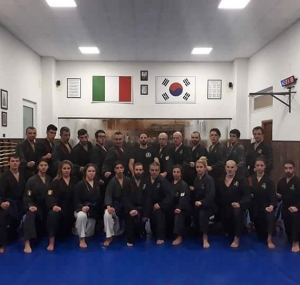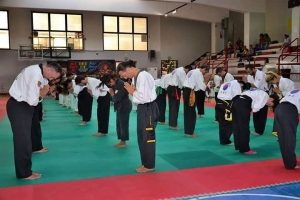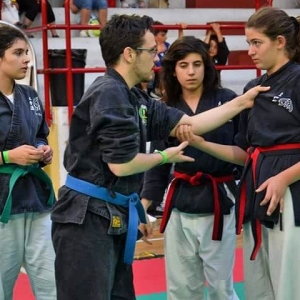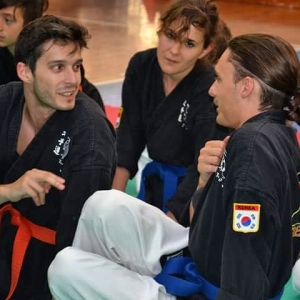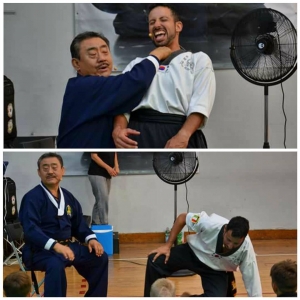What is Hwa Rang Do?
The Most Comprehensive Martial Art in the World
Hwa Rang Do is the most comprehensive system of self-defense and combative techniques in the world. This system has been developed in accordance to the ancient principles of Um-Yang, which emphasizes balance in life and harmony with others and nature.
Hwa Rang Do is the mother art of Tae Soo Do, the undergraduate program that prepares Martial Artists with the fundamentals, basic mechanics, and philosophies inherent in the practice of martial arts.
History & Background of the Art
Hand to Hand Combat
Hand to-hand combat is as old as the human race, and the different fighting styles that prevailed in different regions of the world took generations to evolve. Each individual country developed different combat skills in order to protect their country and their people. The evolution of the Korean combat skills began about 5000 years ago when KoChoSun was established. KoChoSun was a country that started on the Korean peninsula. This country established a strong military warriorship tradition, and their territory spread. Their territory spanned far from the original peninsula, and eventually included all of Manchuria and all most half of China.
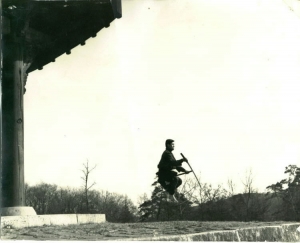 The roots of what is now known by the modern martial art name Hwa Rang Do “The way of the Flowering Manhood” or “The art of the Flower Knights,” which was founded by Dr. Joo Bang Lee, originated from the combat skills of the Hwarang (Hwarang and Rangdo) system of the ancient Silla kingdom of Korea. These secret combat skills, which were called Um Yang Kwon, have survived the passage of time, and have been passed for 58 continuous generations.
The roots of what is now known by the modern martial art name Hwa Rang Do “The way of the Flowering Manhood” or “The art of the Flower Knights,” which was founded by Dr. Joo Bang Lee, originated from the combat skills of the Hwarang (Hwarang and Rangdo) system of the ancient Silla kingdom of Korea. These secret combat skills, which were called Um Yang Kwon, have survived the passage of time, and have been passed for 58 continuous generations.
Before we continue with this martial art history, it is important that we clear any public misunderstandings. In the modern time there have been some ignorant martial art historians that have produced mistaken accounts of history. Along with these historians, there are a number of people throughout the martial art community that have also made false claims about their own martial art and its relationship with the ancient Hwarang system.
These practitioners claim that the roots of their arts came from the ancient Hwarang, even when they have an inadequate understanding of the history of the Hwarang. These types of claims, which are also combined with inaccurate historical references, have been lies and have also caused a great deal of confusion within the public. So before we proceed further, it is imperative that you have an understanding of the terms and vocabulary associated with the ancient kingdom of Silla”s Hwarang warrior system and the martial art identity Hwa Rang Do.
Hwa Rang Do
The martial art name: “The way of the flowering manhood.” This is the name of the martial art identity that was founded in 1960 by Dr. Joo Bang Lee. He is the one who created the syllabus of this martial art for public instruction. He combined the spirit and philosophy of the ancient Hwarang warriors with the ancient secret Hwarang combat skills Um Yang Kwon that were passed to Dr. Lee from his master Suahm Dosa.
HwaRang
“Flower man” The title given to the leaders of the youth group from the ancient kingdom of Silla. This title was only received by the youth of royal family members, and not civilians.
Rangdo
“Fellows” The title of the Hwarang”s fellows. These people were the students disciples, and soldiers of the Hwarang, and all came from the civilian class.
Hwarang(s) – (Hwarangdo)
The term used to refer to the ancient Hwarang warriors. The Hwarang and Rangdo together were called the “Flower knights.” In reference to these individuals as a group of people, the Hwarang (leaders) and Rangdo (fellows), two terms are used. Most references simply say Hwarang (s), but there are some later references that also use Hwarangdo. The “DO” suffix used here means a group of people. So the term pronounced Hwarangdomeans a “group of flower men.”
 As you can see the martial art name Hwa Rang Do (The Way of the Flowering Manhood) and the ancient Hwarang/Hwarangdo (Flower knights) youth group of Silla are different identities. They have the same Korean and English spellings, however their meanings are different. The “DO” term associated with the ancient Hwarang/Hwarangdo means a group of people. However, the “DO” term associated with the martial art Hwa Rang Do means the “Way” or “Art.” The Korean language uses hanja (the characters of the Chinese writing system) as wells as hangul (the Korean alphabet) to produce the written meanings of their language. This combination has created a circumstance where words that have the identical Korean pronunciations also have completely different meanings. For example the hangul word pronounced, “DO” “” in Korean has 45 different meanings associated to it because of this connection with the Chinese language. Another example of this is the hangul word “Mudo .” This word means martial (military) arts , another “Mudo ” means inhumanity, and also another “Mudo ” means dance. Even the word “Hwarang ” has multiple meanings. One is Flower Man “”, and the other is a picture gallery “Hwarang “. Because of these problems with translations, and the difficulties that surround the terms of these languages, we will show the hangul and hanja meanings with a phonetic spelling for an English equivalent. Another reason for this is the popularity of Hwa Rang Do has risen throughout the world, and we need to show these details in order to correct the wrong understandings that have been caused by ignorant histories.
As you can see the martial art name Hwa Rang Do (The Way of the Flowering Manhood) and the ancient Hwarang/Hwarangdo (Flower knights) youth group of Silla are different identities. They have the same Korean and English spellings, however their meanings are different. The “DO” term associated with the ancient Hwarang/Hwarangdo means a group of people. However, the “DO” term associated with the martial art Hwa Rang Do means the “Way” or “Art.” The Korean language uses hanja (the characters of the Chinese writing system) as wells as hangul (the Korean alphabet) to produce the written meanings of their language. This combination has created a circumstance where words that have the identical Korean pronunciations also have completely different meanings. For example the hangul word pronounced, “DO” “” in Korean has 45 different meanings associated to it because of this connection with the Chinese language. Another example of this is the hangul word “Mudo .” This word means martial (military) arts , another “Mudo ” means inhumanity, and also another “Mudo ” means dance. Even the word “Hwarang ” has multiple meanings. One is Flower Man “”, and the other is a picture gallery “Hwarang “. Because of these problems with translations, and the difficulties that surround the terms of these languages, we will show the hangul and hanja meanings with a phonetic spelling for an English equivalent. Another reason for this is the popularity of Hwa Rang Do has risen throughout the world, and we need to show these details in order to correct the wrong understandings that have been caused by ignorant histories.
Claims About Connections to the Hwarang
There are many people who claim a connection to the Hwarang. Some of the common claims come from other martial arts and practitioners. There are claims that Korean Tae Kwon Do came from the Silla Hwarang. Other Tae Kwon Do practitioners say that their art came from the ancient Koguryo kingdom. Hapkido practitioners even make claims in connection to the Silla Hwarang, to Silla royal court martial skill techniques, as well as Kochosun roots. Claims have also arisen from some dishonored and ignorant Korean martial art practitioners. In the modern time there has been an explosion of dishonorable practitioners that have been expelled from their art, are betrayers, or are video tape “practitioners” who all never learn the basics of the honorable way of martial arts, and only copy fighting techniques. They make their own fake style name and lie to the public by coping our history. However, these dishonorable individuals do not know the way of martial art honor. They only make their own “monkey styles” and claim fake historical roots. These fakers even call themselves by a master or even Grandmaster title when nobody gave them that rank.
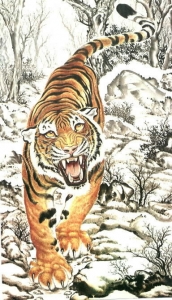 These claims have arisen based upon inaccurate historical accounts and on flat out lies. This is a very serious problem related to the history of all martial arts, and the history of the Hwarang and the martial art Hwa Rang Do in particular. One of the biggest misconceptions is that the martial art Hwa Rang Do existed 2000 years ago. This has happened because there have been some ignorant historians as well as ignorant martial art masters who have not understood the meaning of the terms listed above. They think that the ancient “Hwarang/Hwarangdo ” (Hwarang and Rangdo) group of people is the same as the martial art identity “Hwa Rang Do” founded by Dr. Joo Bang Lee in 1960. This has lead to confusion within the public about Hwa Rang Do and the ancient Hwarang system. In addition to promoting the inaccuracies that have already occurred, there are many people who claim and copy the ancient kingdom of Silla”s Hwarang history and use this as the history of their own martial art. This is not just a problem for the martial art Hwa Rang Do, but it is also a problem for all other martial arts. The quality of the identity and integrity of our martial arts is our honor. As this quality diminishes, all martial arts” honor is destroyed and there is great public confusion. That is why we must know the truth of history and follow the tradition of our martial art that history has left us.
These claims have arisen based upon inaccurate historical accounts and on flat out lies. This is a very serious problem related to the history of all martial arts, and the history of the Hwarang and the martial art Hwa Rang Do in particular. One of the biggest misconceptions is that the martial art Hwa Rang Do existed 2000 years ago. This has happened because there have been some ignorant historians as well as ignorant martial art masters who have not understood the meaning of the terms listed above. They think that the ancient “Hwarang/Hwarangdo ” (Hwarang and Rangdo) group of people is the same as the martial art identity “Hwa Rang Do” founded by Dr. Joo Bang Lee in 1960. This has lead to confusion within the public about Hwa Rang Do and the ancient Hwarang system. In addition to promoting the inaccuracies that have already occurred, there are many people who claim and copy the ancient kingdom of Silla”s Hwarang history and use this as the history of their own martial art. This is not just a problem for the martial art Hwa Rang Do, but it is also a problem for all other martial arts. The quality of the identity and integrity of our martial arts is our honor. As this quality diminishes, all martial arts” honor is destroyed and there is great public confusion. That is why we must know the truth of history and follow the tradition of our martial art that history has left us.
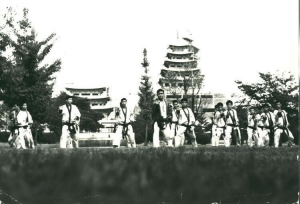 The historical problems related to the history of the ancient Hwarang and the martial art Hwa Rang Do have occurred purposely as well as accidentally. Even the Encyclopedia Britanica has mistaken the identities of the Hwarang (flower man) and the martial art Hwa Rang Do (The way of the flowering manhood). Before 1974, they translated Hwarang/Hwarangdo as, “Flower Knights.” This is an accurate translation of the ancient Hwarang warriors. However, in their later editions they have changed their translation as, ” The way of the Flowering Manhood.” This is the translation that we first used for the martial art identity “Hwa Rang Do”. As our martial art name gained popularity in the 70?s they saw this translation, and took it from our source. Dr. Joo Bang Lee was the first one to use this English translation in the public. Please remember, the martial art Hwa Rang Do”The Way of the Flowering Manhood” and the Hwarang “Flower Man” or the Hwarangdo “Flower Knights” system are different names and are related to different identities. The editorial officer of the World Hwa Rang Do Association has contacted the Encyclopedia Britanica about this issue, and the said they will try to correct this for their next addition. Even so, this is an example of how mistaken historical references have been created, and whether it has been done intentionally or unintentionally it shows that historians must be totally thorough in their efforts. We also hope this explanation clears any misunderstandings from the public as well as in the martial art community regarding the ancient Silla Hwarang youth group and the marital art identity Hwa Rang Do.
The historical problems related to the history of the ancient Hwarang and the martial art Hwa Rang Do have occurred purposely as well as accidentally. Even the Encyclopedia Britanica has mistaken the identities of the Hwarang (flower man) and the martial art Hwa Rang Do (The way of the flowering manhood). Before 1974, they translated Hwarang/Hwarangdo as, “Flower Knights.” This is an accurate translation of the ancient Hwarang warriors. However, in their later editions they have changed their translation as, ” The way of the Flowering Manhood.” This is the translation that we first used for the martial art identity “Hwa Rang Do”. As our martial art name gained popularity in the 70?s they saw this translation, and took it from our source. Dr. Joo Bang Lee was the first one to use this English translation in the public. Please remember, the martial art Hwa Rang Do”The Way of the Flowering Manhood” and the Hwarang “Flower Man” or the Hwarangdo “Flower Knights” system are different names and are related to different identities. The editorial officer of the World Hwa Rang Do Association has contacted the Encyclopedia Britanica about this issue, and the said they will try to correct this for their next addition. Even so, this is an example of how mistaken historical references have been created, and whether it has been done intentionally or unintentionally it shows that historians must be totally thorough in their efforts. We also hope this explanation clears any misunderstandings from the public as well as in the martial art community regarding the ancient Silla Hwarang youth group and the marital art identity Hwa Rang Do.
The Identity of the Hwarang Word
The word and the characters of the Hwarang are generic letters and they are not a martial art name. However, the word and the characters for the martial art Hwa Rang Do are related to the name of a specific martial art identity founded by Dr. Joo Bang Lee. The importance of this relationship between a martial art and its name is connected to the total traditional identity of that present particular martial art instructional name. This means that the name of a martial art is the representation of a specific martial art instructional business identity, and cannot be used for any other martial art style”s identification. This is like the names of the movie industry, Universal Studios or Paramount Pictures. The Hwarang words can be used in modern times by different business categories, like a Hwarang restaurant, a Hwarang soccer team, or a Hwarang store. But it cannot be used by any martial art instructional businesses because our martial art is internationally trademarked and we have the registered right to protect our name throughout the world.
 This is our notice to the public that any other marital art businesses cannot use our name for their school names. Examples of illegal use of our identity”s name are, Hwarang, Hwarangdo, Hwarang musool, Hwarang muyea, Hwarang mudo or in any combination with another martial art names such as Hwarang Tae Kwon Do, Hwarang Hapkido, etc. Also, our Hwa Rang Do never gives permission to use an individual”s personal name with our Hwa Rang Do name. Using a personal name in conjunction with a martial art name is a denial of the same family of that martial art, and also makes it easy for these instructors to break away from their tradition. For example, companies do not use these types of personal names because all employees are working for the ideals and success of that company. That is why we do not have bracnches of these business identites that use names like Kim”s Universal Studios or Mike”s Paramount Pictures.
This is our notice to the public that any other marital art businesses cannot use our name for their school names. Examples of illegal use of our identity”s name are, Hwarang, Hwarangdo, Hwarang musool, Hwarang muyea, Hwarang mudo or in any combination with another martial art names such as Hwarang Tae Kwon Do, Hwarang Hapkido, etc. Also, our Hwa Rang Do never gives permission to use an individual”s personal name with our Hwa Rang Do name. Using a personal name in conjunction with a martial art name is a denial of the same family of that martial art, and also makes it easy for these instructors to break away from their tradition. For example, companies do not use these types of personal names because all employees are working for the ideals and success of that company. That is why we do not have bracnches of these business identites that use names like Kim”s Universal Studios or Mike”s Paramount Pictures.
Because of this, the titles of our academies use the name of the city of the school added to Hwa Rang Do. For example schools are called Hwa Rang Do Academy of Madison, WI, or Hwa Rang Do Academy of Arcata, CA. Similar to the names of our academies, all other countries use the name of their country as a chapter of the World Hwa Rang Do Association. For example they would be called the Korean chapter of the World Hwa Rang Do Association or the German chapter of the World Hwa Rang Do Association. This way there is only one governing organization for Hwa Rang Do throughout the entire world. This organization is controlled by the Hwa Rang Do World Headquarters which is located in Do Joo Nim”s living area. Some reasons for these polices is also because of the rise in disrespectful and dishonorable martial artists who have made their own kwan, won, organizations and as well as their own fake styles using the same techniques as their original system. These fake “creations” then go by the maiden name of these people (example: Kim”s Hwa Rang Do Association). The individuals who have done this were expelled or betrayed their original art, and are now only damaging and destroying their art”s honor and identity. So we have this rule to protect our art from those who were expelled by breaking the rules of our tradition, as well as others who have damaged our strong sense of familyship, and who do not respect martial art loyalty. If you need any details about our rules and laws please check out our rules and bylaws.
The history of Hwa Rang Do is very unique, and the introduction of its concepts and techniques to the public is the result of one man”s vision. Our founder Dr. Joo Bang Lee is the one and only source of this system in the world, and without him nobody would know these skills. Nobody was even using the martial art name Hwa Rang Do before him. Please keep this in mind as you read this history, because the tradition of this martial art follows the traditional ways of a martial art. This means that principles of human morality are extremely important to its practitioners. Principles such as honor, loyalty, respect, and duty are the integral components that create the quality and integrity of our martial art identity. That is why there is one governing organization in the world of our martial art, the World Hwa Rang Do Association and the one Hwa Rang Do World Headquarters. It is this organization and world headquarters that certifies all schools, masters, and instructors as well as creating policies that ensure our identity is not dishonored. An example of this, is the World Hwa Rang Do association has registered an international trademark and copyright of our martial art Hwa Rang Do, which means any aspect of our art cannot be used without permission. This includes our name, techniques, uniforms, concepts, etc. . . Another important act of this association is we post all certified schools, black sashes, instructors, masters, and their ranks on our web site. This way the public throughout the world can know if a claim about rank from a particular individual is earned and true. If someone makes the claim that they are a Hwa Rang Do instructor and they are not on this listing or do not have our founder”s certification, they are a faker and liar. So please check first, before you train. If you want to join our Hwa Rang Do family please contact the Hwa Rang Do World Headquarters and we will direct you to the best option for training in this art.
Historical Development and Influence Begins
The tradition of the Hwarang system has existed for over 2,000 years, and during this time it has developed into an incredibly influential force. The impact of the Hwarang system and people was strongly felt in the East Asian region in ancient times, and has also reverberated through time, leaving a lasting mark for us. The Korean combat skills originally began over 5,000 years ago with the formation of the Kochosun kingdom. In order to protect the people and their territory this kingdom began the development of a strong combative system. Later, over 2,000 years ago, the kingdom of Silla (BC 57) was formed and they began the development of their own warrior system.
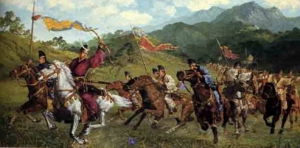 This Hwarangdo system eventually spread to Japan and was very influential in the development of the Japanese Samurai system and Bushido (Korean-Musado, this is the moral mentality of the Hwarang and samurai). During this time much of the Japanese culture originated from the Korean kingdoms of Silla, Koguryo and Packche. Along with social customs, martial aspects were passed across the sea to Japan. So the counterpart of the Silla Hwarang was the Japanese Shogun, and the counterpart of the Silla Rangdo was the Japanese shogun”s soldiers (their samurai). It is also thought that the family of the founder of Jujitsu was also connected to the Hwarang warriors. The name of this “Jujitsu ” founder is “Shinna Sabro “, and the Korean pronunciation of his name is “Silla Samrang.” There were many Koreans who moved to other countries, and because they still felt strong ties to their homeland they used this kingdom”s name as their maiden name. The meaning of this founder”s name is “Silla third man,” so it is thought that this founder”s ancestors came from the kingdom of “Silla “.
This Hwarangdo system eventually spread to Japan and was very influential in the development of the Japanese Samurai system and Bushido (Korean-Musado, this is the moral mentality of the Hwarang and samurai). During this time much of the Japanese culture originated from the Korean kingdoms of Silla, Koguryo and Packche. Along with social customs, martial aspects were passed across the sea to Japan. So the counterpart of the Silla Hwarang was the Japanese Shogun, and the counterpart of the Silla Rangdo was the Japanese shogun”s soldiers (their samurai). It is also thought that the family of the founder of Jujitsu was also connected to the Hwarang warriors. The name of this “Jujitsu ” founder is “Shinna Sabro “, and the Korean pronunciation of his name is “Silla Samrang.” There were many Koreans who moved to other countries, and because they still felt strong ties to their homeland they used this kingdom”s name as their maiden name. The meaning of this founder”s name is “Silla third man,” so it is thought that this founder”s ancestors came from the kingdom of “Silla “.
Japanese soft styles such as Judo (mostly a sport version of throwing and chocking), Daitoryu Yawara (same as Aiki Jujitsu – mostly throwing, joint manipulation, and grappling), and Aikido (mostly the use of an opponent”s strength, and joint manipulation) were the same skills that evolved from Jujitsu. But, in Japan the Daitoryu yawara (Aiki Jujitsu) and Jujitsu name has been disbanded, and presently these branch schools are called Judo and Aikido schools. However, the Jujitsu that has become poular in present times is called Brazilian Jujitsu and is mostly focused on grappling and ground locks. All of these Japanese soft style skills share many similarities with the soft style “Yusool” skills of the ancient secret combat skills of the Hwarang which are called “Um Yang Kwon ” (Yusool -soft skills and Kangsool -hard skills). Because of these many similarities and the meaning of the founder”s name, it is thought that Jujitsu”s roots lie in the Hwarang tradition of Korea.
 Much of the influence of this Hwarang tradition is due to the arrival of King Chinhung (540 AD), who was also a Hwarang. The Hwarang system existed before King Chinhung, but he was the individual who greatly developed the power and strength of this system within his administration and military. After his arrival followed a long period of wars of expansion with the larger kingdom to the north, Koguryo. However, before the northern kingdoms were engaged, King Chinhung took on the task of driving out the Japanese colonies to the east, which were in alliance with the Yamato clan of Japan. Ten years later, King Chinhung turned his armies onto the fertile valleys of west and central Korea, between the Han and Imjin Rivers. This was the Pakche kingdom, and the conquest of the Han-Imjin river area brought great wealth to Silla through the acquisition of the richest agricultural lands in the peninsula, additional military service, and the labor of the peasantry. This conquest also opened an easier route to China through the capture of the ports on the Yellow Sea. Because of the Hwarang warriors of Silla, these three countries were unified for the first time.
Much of the influence of this Hwarang tradition is due to the arrival of King Chinhung (540 AD), who was also a Hwarang. The Hwarang system existed before King Chinhung, but he was the individual who greatly developed the power and strength of this system within his administration and military. After his arrival followed a long period of wars of expansion with the larger kingdom to the north, Koguryo. However, before the northern kingdoms were engaged, King Chinhung took on the task of driving out the Japanese colonies to the east, which were in alliance with the Yamato clan of Japan. Ten years later, King Chinhung turned his armies onto the fertile valleys of west and central Korea, between the Han and Imjin Rivers. This was the Pakche kingdom, and the conquest of the Han-Imjin river area brought great wealth to Silla through the acquisition of the richest agricultural lands in the peninsula, additional military service, and the labor of the peasantry. This conquest also opened an easier route to China through the capture of the ports on the Yellow Sea. Because of the Hwarang warriors of Silla, these three countries were unified for the first time.
Who Were the Hwarang?
One of the most significant acts by King Chinhung was the development of the Hwarang system within his military service. This Hwarang system was organized by groups of youths who went to mountains, rivers and other places of natural beauty to learn to develop human morality, loyalty, and mental and emotional control along with their combat skills. Through this development of strong mental, physical and spiritual training they were taught to act as models of their culture and chivalrous warriors. They were Silla”s elite warriors. They were called Hwarang (Flower Knights) and Rangdo (a Hwarang”s disciple or soldier). These were young men who exemplified the warrior-intellectual that influenced the Silla kingdom”s history for many centuries. A 13th century monk recorded that the Silla kingdom had “issued a decree and chose boys from good royal families who were of good morals and renamed them Hwarang (title of leader or General). Hwarang Sor Won was to be admitted as a Kuksun (Dae Jang Gun or head General). This was the beginning of the Hwarang (JanGun-General) and Rangdo (SaByoung -soldiers) special integration within the military system. During this time these warriors were called Hwarangdo (Hwarang and Rangdo group of people) which means the flowering knights and their warriors.
Besides religious instruction, the Hwarang were taught traditional dance and songs for their emotional development. Literature, the arts, and sciences were taught for their academic development. They were also taught the art of warfare, archery, combative skills etc. Their combat skills are based upon the concept of the unity of opposites embodied in the um-yang . Their empty-handed fighting techniques were known for their blending of the hard and soft, linear and circular attacks. A linear thrust punch could break through the wooden armor of an opponent and kill him instantly. They could also spin kick at such speeds that their enemies frequently thought that the feet of the Hwarang warriors were swords. Also they learned 108 different weapons within their curriculum.
The eighth century Silla historian, Kim Taemun, noted in his Hwarang chronicle. “Sagacious counselors and loyal ministers follow the Hwarang and Rangdo; they produce great generals and brave soldiers.” The rank of Hwarang signified the position of a teacher of the their combat skills and he commanded 500 to 5,000 students, who were called Rangdo. A Kuksun possessed the rank of head general (Dae Jang Gun) in the army. The ferocious fighting spirit of the Hwarang warriors became legendary, and their exploits were recorded for posterity in Hwa Rang poetry and literature. The Hwarang narratives of the Silla dynasty became the basis of the classical novel that formed the backbone of Korean literature for a thousand years.
Examples of the Strong Moral Mentality of the Hwarang
One of the most famous stories eulogized by Hwarang literature is the martyrdom of the son of General P”umil, who died in the wars of unification. Kwan Chang was a Hwarang commander at the age of 16. He was captured during a battle with Paekche, one of the western kingdoms. Since his high ranking battle crest indicated he was the general”s son, he was taken before the Paekche general. Lifting his war helmet, the Paekche general was taken aback at his youth. Thinking of his own young son, he decided against execution, which was the usual fate of the captured officers, and returned him to Silla lines. Kwan Chang went before his father and asked that he be sent back into battle at the head of his men. General P”umil agreed. He was captured after a day-long battle, but after he was disarmed, he broke loose from his guards, killing both of them by hand and attacked the Paekche general”s second in command. A leaping, spin kick killed the commander as he sat on his horse, a full eight feet in the air. Finally subdued, he was taken before the Paekche general. Much distressed over the loss of his chief commander, he told Kwan Chang, “I gave you your life once because of your youth, but now you return to take the life of my best field commander.” This time the Paekche general returned the boy”s head attached to the saddle of his war horse. At the Silla line, General P”umil grasped his son”s head and wiped off the blood with his sleeve. “My son”s face is as when he was alive!” he shouted to his men. “He was able to die in the service of the king. There is nothing to regret.” The General rode back into battle to complete the final defeat of Paekche. This was the famous Hwang San Bul battle and the story became legendary throughout Korean culture.
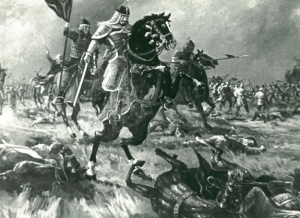 Heroic legends of the Hwarang warriors were preserved in many forms: dances, poetry and literature. They were told and retold from one generation to another and provided an example for the young of each generation to follow. The fighting spirit of the Silla warriors was so widely known that even the most powerful enemies hesitated to attack.
Heroic legends of the Hwarang warriors were preserved in many forms: dances, poetry and literature. They were told and retold from one generation to another and provided an example for the young of each generation to follow. The fighting spirit of the Silla warriors was so widely known that even the most powerful enemies hesitated to attack.
One of the most famous stories that illustrates the respect that the country of Tang (as China was known in this period) had for the people of Silla, is told about the young Hwarang general named Yoo Shin Kim. General Kim was 15 at the time he became a commander in the army. Some years later China and Silla were in an alliance in a war against Paekche. The Silla armies had engaged Paekche in a battle and defeated them. But the battle had taken several days and it caused the Silla commander, Moon Kyung Kim, to be late for a meeting with the Chinese general, who was the top commander in this temporary alliance.
The Hwarang commander and General Kim went before the Chinese General Jung Bang So to report the good news of their victory. But General So wanted to punish the Silla Commander for his disobedience and late arrival, so he ordered his execution! Suspecting treachery, that China”s real intentions were to first take Paekche and then turn on Silla, General Kim spoke out angrily, “Are we your allies or your slaves?” Then in a burst of fury he exploded, “I will first fight with your army and then we will defeat Paekche.” Kuksun Yoo Shin Kim”s sword rose from its scabbard by itself into his hand and he was about to take the life of the Chinese general. It was thought in those times that the sword was the soul of the warrior and that it followed the mind of its master. Seeing this, General So was taken with fright. He quickly apologized to General Kim and rescinded the order of execution.
Paekche was defeated and Silla prepared for a war with China. However General So was afraid to attack Silla and returned home to China. Asked by the Emperor why he had not taken Silla also, General So said, “It is true that Silla is a small country, but their King is very wise and the generals are fierce and loyal. All the people are united in a strong camaraderie.” He repeated the incident with the Hwarang commander and said, “they are small, but we cannot defeat them.”
Another story which revealed the depth of familial bonds of the Silla period concerned the death of the Hwarang General Bi Yeng Ja. Asked by General Kim to lead a suicide attack against a large Chinese force. Hwarang Bi Yeng Ja replied, “You have given me a great honor to show loyalty to my king and country.” He then requested that the general watch over his son and prevent him from following him into battle. Since Hwarang Bi Yeng Ja had only one son, he was concerned that his family name live another generation. General Kim assured him that he would watch over his son. Hwarang Bi Yeng Ja entered battle and was killed. Upon witnessing the death of his father, the son mounted his horse and followed his father into battle and was killed too. Then followed the house manager and servant who were also killed. The whole Silla army witnessed this act of loyalty and, swept with a wave of sympathy for this act of sacrifice, charged into battle to avenge the death of the Bi family. They defeated the Chinese armies and saved Silla from almost certain conquest.
Fraternal loyalties among the Hwarang warriors were frequently as strong as familial ties. Another story is about Hwarang Sa Da Ham who was 15 years old when he became a Hwarang under King Chinhung. In a war with the Northern kingdoms, Sa Da Ham pleaded with the King that he be allowed to lead the first attack. In spite of Hwarang Sa Da Ham”s young age, the King consented so as to demonstrate the bravery of the Hwarang youth. Sa Da Ham led the army into battle against a fortress and he was the first to breach the gate. For his bravery, King Chinhung gave him 300 slaves from the defeated army, but Hwarang Sa Da Ham gave them their liberty and wished no personal rewards for his deeds.
In this war, Hwarang Sa Da Ham lost his closest comrade, Hwarang Moo Kwan Rang. From early childhood the two young friends had a death pact that obliged each to commit suicide should one or the other die in battle. Sa Da Ham heard of his friend”s death and fell into remorse and mourning. He refused to eat or sleep for seven days. He died on the seventh day, and his sacrifice was eulogized in Hwarang novels for centuries to come.
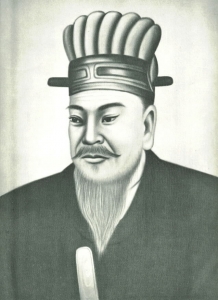 The story of Hwarang Won Sool, the second son of Dae Jang Gun Kuksun Yoo Shin Kim, commander of the Silla army, is similar in its importance. Hwarang Won Sool was a lieutenant in the army when it suffered a defeat at the hands of Chinese troops. Upon his return, his father requested permission from King Moon Moo to execute his son for the disgrace he brought on the family and the country. But King Moon Moo replied that the boy was not in command and therefore was not responsible for the defeat. But the father banished his son into exile in the mountains as a monk. When the father died Won Sool came back down from the mountain to face his mother, but she refused to see him replying that she would not violate the father”s command. Won Sool returned to Tae Bak Mountain. Some years later China launched another war. Hwarang Won Sool heard of the impending war and returned to the King to request that he be allowed to enter the battle. He was given a command and performed brilliantly. King Moon Moo wanted to reward him, but Won Sool refused, saying that his family held him in shame and that he could not accept. He returned to his mountain once again to live out his life as a hermit monk.
The story of Hwarang Won Sool, the second son of Dae Jang Gun Kuksun Yoo Shin Kim, commander of the Silla army, is similar in its importance. Hwarang Won Sool was a lieutenant in the army when it suffered a defeat at the hands of Chinese troops. Upon his return, his father requested permission from King Moon Moo to execute his son for the disgrace he brought on the family and the country. But King Moon Moo replied that the boy was not in command and therefore was not responsible for the defeat. But the father banished his son into exile in the mountains as a monk. When the father died Won Sool came back down from the mountain to face his mother, but she refused to see him replying that she would not violate the father”s command. Won Sool returned to Tae Bak Mountain. Some years later China launched another war. Hwarang Won Sool heard of the impending war and returned to the King to request that he be allowed to enter the battle. He was given a command and performed brilliantly. King Moon Moo wanted to reward him, but Won Sool refused, saying that his family held him in shame and that he could not accept. He returned to his mountain once again to live out his life as a hermit monk.
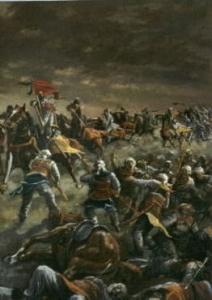 These stories, which became part of the Korean folklore and heroic legend, were not idle fairy tales, but models of the martial code of chivalry. This code evolved into a system of ethics and morality that was essential to the Hwarang warrior”s mentality. The ego and self-interest was never sufficient to sustain such a commitment.
These stories, which became part of the Korean folklore and heroic legend, were not idle fairy tales, but models of the martial code of chivalry. This code evolved into a system of ethics and morality that was essential to the Hwarang warrior”s mentality. The ego and self-interest was never sufficient to sustain such a commitment.
The development of a code of ethical behavior was achieved by the monk Won Kwang Bopsa. He told his young disciples Hwarang – Kwi San and Chu Hang, “The society of the Silla people already had five rules called Sae Sok Ohkae, but I command you to give these five rules to the Hwarang warriors for their rules of life.” From this point on these five rules are called the Hwarang Ohkae. These five rules have been passed down and held by the Hwarang warriors from every generation since Won Kwang Bopsa first gave them to his two Hwarang disciples.
The End of an Era
This Hwarang system was passed through the Koryo dynasty. However, the name of this system was changed to kuksondo and pungwealdo during this time. Even so, this system existed in the same capacity until one Hwarang Jang Gun (general) Sung Gae Yi (or Lee) took over the Koryo kingdom and established the new country of Chosun (1392 AD). The third king of Chosun, King Tae Jong (the fifth son of Sung Gae Lee) destroyed the Hwarang system when he initiated a policy that ordered all of the independent Jang Guns” (Hwarang generals) personal soldiers to be under his control. King Tae Jong was afraid of the power that the individual Hwarang generals had. King Tae Jong believed that the possibility of another strong Jang Gun attacking his reign was great. So this policy was created in order to destroy all of the power that these individual Jang Guns held. This act eliminated the Hwarang system from the public which was based on the relationship between the Jang Gun and his soldiers.
After giving the king their soldiers, some Hwarang generals left the kingdom. They left society and turned to mountain life or became monks. It was almost 600 years that the Hwarang system and these Hwarang combat skills did not exist in the public society of Korea. The combat skills of the ancient Hwarang were only passed secretly from one monk to one monk, until they were passed to Suahm Dosa. He is the 57th generation Hwarang title holder and master of the secret ancient Hwarang combat skills called Um Yang Kwon . He in turn, passed these secret skills to two young boys, Joo Bang Lee and his brother Joo Sang Lee.
The Return of the Secret Hwarang Combat Skills to the Public
It was in 1942 that Lee”s father went to Suahm Dosa at the So Kwang Sa temple in Ham Nam province of Korea (present time North Korea). He asked Suahm Dosa to teach two of his sons his ancient skills. Suahm Dosa accepted these brothers and began training them in the secret ancient Hwarang combat skills. In 1945 Korea gained its independence from the Japanese occupation (1910-1945). However, after this, Korea was divided into the northern communist territory and the southern democratic territory. So in 1948 Lee”s family and Suahm Dosa escaped together to the south. The Lee family settled in Seoul and Suahm Dosa moved to the Yang Mi Ahm sanctuary on Ohdae Mountain. Later in 1960 the Lee brothers opened their first school. It had been almost 600 years since these Hwarang combat skills were taught in the public. With the establishment of their Hwarang Musool (Hwa Rang Do) dojang the Lee brothers ended the secret passage of these Hwarang combat skills. Founder Dr. Joo Bang Lee and his brother also created the public syllabus for this new martial art identity Hwa Rang Do, that they founded. When they founded this martial art identity they divided and created the categories of techniques and ranking system for their public training system from what they had been taught by their master Suahm Dosa.
 In July of 1969 Suahm Dosa passed away. However, before his death he gave the 58th generation Hwarang title holder and Do Joo Nim (owner of art) position to Dr. Joo Bang Lee. In 1968, Dr. Joo Bang Lee registered the Hwa Rang Do name with the Korean Government and founded the Korean Hwa Rang Do Association. Also in 1968, Head Grandmaster (KukSunNim) JooSang Lee moved to America and opened the first Hwa Rang Do school in the United States in Los Angeles, California. Later in 1972 Hwa Rang Do Supreme Grandmaster Dr. Joo Bang Lee moved to America and opened the World Hwa Rang Do Association and the Hwa Rang Do World Headquarters in Downey, California. Most martial art”s World Headquarters follow their founder”s living place. So the Korean secret ancient combat skills receiver and martial art Hwa Rang Do founder left his homeland and relocated the homeland of his art and the World Headquarters to America.
In July of 1969 Suahm Dosa passed away. However, before his death he gave the 58th generation Hwarang title holder and Do Joo Nim (owner of art) position to Dr. Joo Bang Lee. In 1968, Dr. Joo Bang Lee registered the Hwa Rang Do name with the Korean Government and founded the Korean Hwa Rang Do Association. Also in 1968, Head Grandmaster (KukSunNim) JooSang Lee moved to America and opened the first Hwa Rang Do school in the United States in Los Angeles, California. Later in 1972 Hwa Rang Do Supreme Grandmaster Dr. Joo Bang Lee moved to America and opened the World Hwa Rang Do Association and the Hwa Rang Do World Headquarters in Downey, California. Most martial art”s World Headquarters follow their founder”s living place. So the Korean secret ancient combat skills receiver and martial art Hwa Rang Do founder left his homeland and relocated the homeland of his art and the World Headquarters to America.
Hwa Rang Do’s Divisions
The Hwa Rang Do Founder Dr. Joo Bang Lee divided four categories of his martial art. From the Musool (martial skills) aspects, there is Nae Kong (internal power), Wae Kong (external power), Mu Gi Kong (weapon power), Shin Kong (mental power), and 280 different categories of over 4000 techniques. He also divided the Insool (healing skills) aspects into the six categories of Ji Ap Sool (acupressure), Chim Gu Sool (acupuncture and maxabustion), Yak Bang Bop (herbal medicine), Jup Gol Sool (bone setting), Hwal bop (Special Aids), Ki Ryuk Sool (Ki Power healing). Hwa Rang Do is not only an art based on self-defense. As well as being a martial art it is also a healing art.
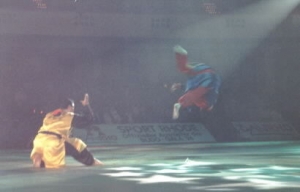 Along with having this incredible array of skills, one of the most important priorities of all Hwa Rang Do practitioners is the development of their characters. Their mentality is based from the Hwarang Ohkae, the code of ethics of the ancient Hwarang, as well as the Hwa Rang Do Kyo Hoon, which are Founder Dr. Joo Bang Lee”s nine principles of human morality. Hwa Rang Do training is not only about fighting techniques. Hwa Rang Do first counts a strong human moral mentality. That is why the “Way” of Hwa Rang Do includes strong discipline as well as the study of philosophy and human morality.
Along with having this incredible array of skills, one of the most important priorities of all Hwa Rang Do practitioners is the development of their characters. Their mentality is based from the Hwarang Ohkae, the code of ethics of the ancient Hwarang, as well as the Hwa Rang Do Kyo Hoon, which are Founder Dr. Joo Bang Lee”s nine principles of human morality. Hwa Rang Do training is not only about fighting techniques. Hwa Rang Do first counts a strong human moral mentality. That is why the “Way” of Hwa Rang Do includes strong discipline as well as the study of philosophy and human morality.
Concluding Remarks
This martial art Hwa Rang Do is very different from other martial arts. Most founders of all other martial arts have passed away and their students have made many different “Kwan”, “ryu”, or “Won” from their one original martial art name. Because of this there are so many different and conflicting histories for the same martial art name. Along with these conflicting histories, there is a plethora of schools and organizations that have been made by dishonored or espelled students. These circumstances are the main reasons that most martial art identities have lost the integrity of their name. And because of this people have began to discard their martial art identities completely. That is why we have seen a rise in individuals who call their school Kim”s Martial Art Academy or Monkey”s Martial Art Academy. It is like these people do not have a martial art identity name.
However, this history of Hwa Rang Do set here, is the one true history of our art”s identity. Our founder, Dr. Joo Bang Lee is the one who brought this art to the public and is the one and only source of the aspects and techniques from this tradition. The roots of the martial art Hwa Rang Do are from the ancient Hwarang warriors of the the kingdom of Silla. These combat skills and the Hwarang title have survived the test of time, by being passed down for 58 continuous and unbroken generations to our art”s founder. The way of the Hwarang system is still intact, and the Hwarang we equally count as our instructors and masters, and the Rangdo as the students and desciples. And through the adherence to the Hwa Rang Do Meng Sae, our five ethical rules and the founder”s nine principles of human morality, we will have a strong moral mentality, which will ensure that our martial art Hwa Rang Do will be passed on for at least another 2,000 years!



